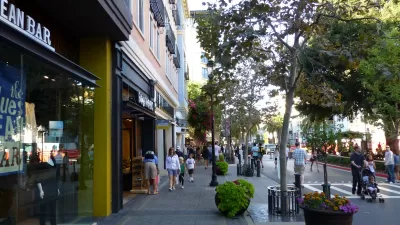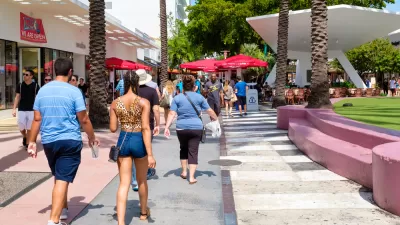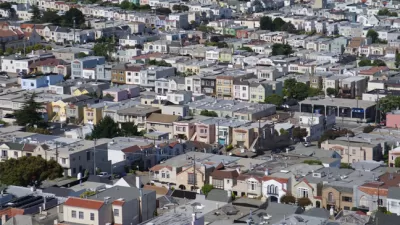Despite its mostly sprawling conditions, San Jose has recently prioritized walkable, dense urban environments. But should the city focus its development downtown or build a connected network of urban neighborhoods?
Urbanists are keeping a close eye on the development prospects of San Jose in the Silicon Valley. The sprawling city has, in recent years, attempted to overcome its suburban development patterns, “[shifting] its strategic focus to increasingly dense, urban development, implementing a downtown high-rise incentive program, fast-tracking new residential towers and adding citywide bike lanes,” writes Lauren Hepler.
New development possibilities outside of Downtown, however, stir controversy among Downtown stakeholders who would like to concentrate development in the core. The controversy was given new fuel at the hint of large-scale development plans in a section of town called Santana Row. In an earlier article, Hepler details the deal creating the consternation: “The owner of the San Jose shopping and socializing hub, Maryland-based Federal Realty Investment Trust, Wednesday said it has entered ‘a long-term’ land lease for the 11.6-acre Century Theatres site located just across Winchester Boulevard from Santana Row.”
The possibilities seem in line with the urban ambitions of the city, “[but] any new development would likely run into old criticisms; Santana Row's location outside of downtown San Jose has always been a sticking point for advocates of more centralized urban development,” explains Halpern in the later article.
Others, however, argue that San Jose can have more than one focal point of development. Even the august observer SPUR argued for the city “to better link and promote areas surrounding downtown, like the Alameda, Japantown, Santana Row and Willow Glen,” in a recent report on San Jose. Hepler quotes the report, which says the city should "reframe the surrounding areas as an asset to downtown, not a threat."
FULL STORY: The Santana Row conundrum: Is San Jose's future urban density, suburban sprawl or both?

Alabama: Trump Terminates Settlements for Black Communities Harmed By Raw Sewage
Trump deemed the landmark civil rights agreement “illegal DEI and environmental justice policy.”

Study: Maui’s Plan to Convert Vacation Rentals to Long-Term Housing Could Cause Nearly $1 Billion Economic Loss
The plan would reduce visitor accommodation by 25% resulting in 1,900 jobs lost.

Planetizen Federal Action Tracker
A weekly monitor of how Trump’s orders and actions are impacting planners and planning in America.

Waymo Gets Permission to Map SF’s Market Street
If allowed to operate on the traffic-restricted street, Waymo’s autonomous taxis would have a leg up over ride-hailing competitors — and counter the city’s efforts to grow bike and pedestrian on the thoroughfare.

Parklet Symposium Highlights the Success of Shared Spaces
Parklets got a boost during the Covid-19 pandemic, when the concept was translated to outdoor dining programs that offered restaurants a lifeline during the shutdown.

Federal Homelessness Agency Places Entire Staff on Leave
The U.S. Interagency Council on Homelessness is the only federal agency dedicated to preventing and ending homelessness.
Urban Design for Planners 1: Software Tools
This six-course series explores essential urban design concepts using open source software and equips planners with the tools they need to participate fully in the urban design process.
Planning for Universal Design
Learn the tools for implementing Universal Design in planning regulations.
Caltrans
Smith Gee Studio
Institute for Housing and Urban Development Studies (IHS)
City of Grandview
Harvard GSD Executive Education
Toledo-Lucas County Plan Commissions
Salt Lake City
NYU Wagner Graduate School of Public Service





























